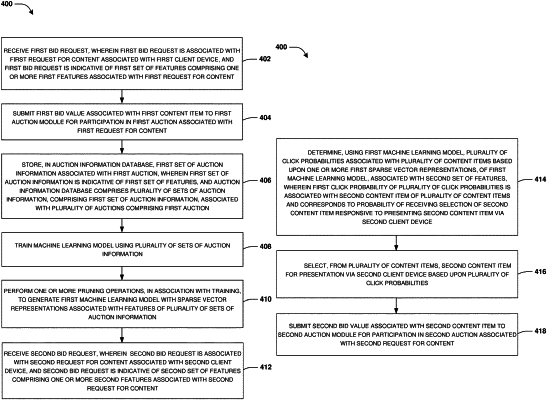| CPC G06Q 30/0275 (2013.01) [G06N 3/082 (2013.01); G06N 20/00 (2019.01)] | 20 Claims |

|
1. A method, comprising:
receiving a first bid request, wherein:
the first bid request is associated with a first request for content associated with a first client device; and
the first bid request is indicative of a first set of features comprising one or more first features associated with the first request for content;
submitting a first bid value associated with a first content item to a first auction module for participation in a first auction associated with the first request for content;
storing, in an auction information database, a first set of auction information associated with the first auction, wherein:
the first set of auction information is indicative of the first set of features; and
the auction information database comprises a plurality of sets of auction information, comprising the first set of auction information, associated with a plurality of auctions comprising the first auction;
training, in real time, a machine learning model using the plurality of sets of auction information;
performing one or more pruning operations, in association with the training, to generate a first machine learning model with sparse vector representations associated with features of the plurality of sets of auction information;
receiving a second bid request, wherein:
the second bid request is associated with a second request for content associated with a second client device; and
the second bid request is indicative of a second set of features comprising one or more second features associated with the second request for content;
determining, using the first machine learning model, a plurality of click probabilities associated with a plurality of content items based upon one or more first sparse vector representations, of the first machine learning model, associated with the second set of features, wherein a first click probability of the plurality of click probabilities is associated with a second content item of the plurality of content items and corresponds to a probability of receiving a selection of the second content item responsive to presenting the second content item via the second client device;
selecting, from the plurality of content items, the second content item for presentation via the second client device based upon the plurality of click probabilities; and
submitting a second bid value associated with the second content item to a second auction module for participation in a second auction associated with the second request for content.
|